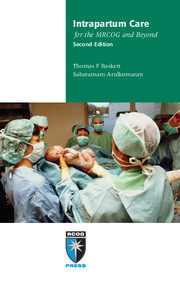Book contents
- Frontmatter
- Contents
- Preface
- Abbreviations
- 1 Improving intrapartum care
- 2 First stage of labour
- 3 Second stage of labour
- 4 Fetal surveillance in labour
- 5 Third stage of labour
- 6 Lower genital tract trauma
- 7 Induction of labour
- 8 Preterm labour and prelabour rupture of membranes
- 9 Assisted vaginal delivery
- 10 Shoulder dystocia
- 11 Breech vaginal delivery
- 12 Twin and triplet delivery
- 13 Caesarean section
- 14 Vaginal birth after caesarean section
- 15 Uterine rupture
- 16 Emergency obstetric hysterectomy
- 17 Cord prolapse
- 18 Antepartum haemorrhage
- 19 Postpartum haemorrhage
- 20 Acute uterine inversion
- 21 Amniotic fluid embolism
- 22 Disseminated intravascular coagulation
- 23 Acute tocolysis
- 24 Severe pre-eclampsia and eclampsia
- 25 Neonatal resuscitation
- 26 Perinatal loss: management of late fetal death and stillbirth
- Index
11 - Breech vaginal delivery
Published online by Cambridge University Press: 05 July 2014
- Frontmatter
- Contents
- Preface
- Abbreviations
- 1 Improving intrapartum care
- 2 First stage of labour
- 3 Second stage of labour
- 4 Fetal surveillance in labour
- 5 Third stage of labour
- 6 Lower genital tract trauma
- 7 Induction of labour
- 8 Preterm labour and prelabour rupture of membranes
- 9 Assisted vaginal delivery
- 10 Shoulder dystocia
- 11 Breech vaginal delivery
- 12 Twin and triplet delivery
- 13 Caesarean section
- 14 Vaginal birth after caesarean section
- 15 Uterine rupture
- 16 Emergency obstetric hysterectomy
- 17 Cord prolapse
- 18 Antepartum haemorrhage
- 19 Postpartum haemorrhage
- 20 Acute uterine inversion
- 21 Amniotic fluid embolism
- 22 Disseminated intravascular coagulation
- 23 Acute tocolysis
- 24 Severe pre-eclampsia and eclampsia
- 25 Neonatal resuscitation
- 26 Perinatal loss: management of late fetal death and stillbirth
- Index
Summary
The fetus presents by the breech in 3–4% of all deliveries, making it the most common malpresentation. Since the last decade of the 20th century, debate has continued as to whether the breech fetus is more safely delivered by caesarean section or by assisted vaginal delivery in selected cases. During this time most obstetricians in developed countries ‘voted with their scalpels’, such that there was a steady increase in the proportion of breeches delivered by caesarean section. For many the debate was answered in favour of caesarean delivery with the publication in 2000 of the Term Breech Trial, a Canadian-organised international multicentre randomised trial. Indeed, elective caesarean delivery of the breech fetus was widely adopted and in at least one national survey recorded an improvement in neonatal outcome. Thus, where facilities existed, the standard of care became elective caesarean delivery for the fetus in breech presentation at term. Although the Term Breech Trial showed a significant improvement in neonatal mortality and morbidity with elective caesarean delivery, the infant outcome at 2 years of age was similar in both groups. In recent years there have been publications advocating selective vaginal delivery of the term breech, supported in some cases by institutional data. Some national guidelines have been modified to support those obstet ricians willing to offer selective vaginal delivery, although the vast majority of cases are still delivered by caesarean section.
Although the Term Breech Trial applied only to the term breech, most obstetricians also deliver the preterm breech fetus by caesarean section, without objective evidence that it is safer for the neonate.
- Type
- Chapter
- Information
- Intrapartum Care for the MRCOG and Beyond , pp. 133 - 144Publisher: Cambridge University PressPrint publication year: 2011



